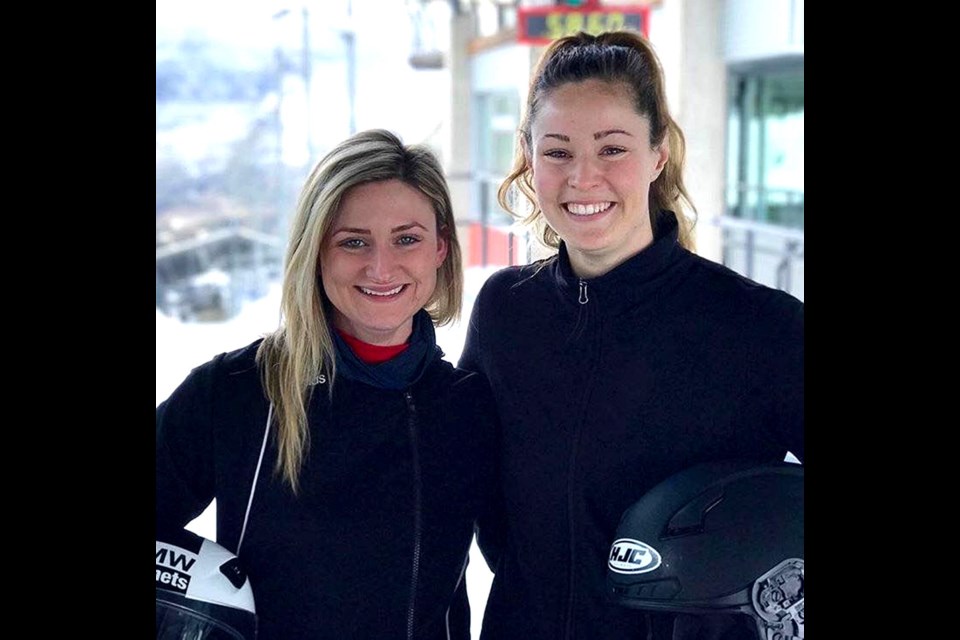Burnaby-based bobsledder Julie Johnson, and her brakeman Kori Hol, finished ninth at the women’s world junior two-man blobsleigh championships in St. Moritz, Switzerland three weeks ago.
It’s a long way from Blackstrap Mountain, the 45-metre man-made molehill outside Hanley, Sask., where 25-year-old Johnson, who trains at Fortius Sport and Health, tobogganed as a kid.
Johnson and Hol were Canada’s only team at the world junior championships that brought the top competitors under the age of 26 to the 1,722-metre, naturally refrigerated track with 19 curves that snakes down the side of a Swiss mountain at an average gradient of 8.14 per cent.
It’s a huge step up in an athletic pursuit that started with a 40-second public tourist run at the Whistler sliding centre.
Her pilot that spring day in 2014 was two-time Canadian Olympian Kaillie Humphries.
“It’s such a shock to the system,” said Johnson of the ride she signed up for while taking a break from her studies in kinesiology at the University of British Columbia. “I think I forgot to breathe and definitely remember feeling G forces in my back through the final corner.”
In fact, the experience so enthralled Johnson she started researching the sport and connected with a coach, Pat Brown.
“I saw an opportunity to be a competitive athlete again,” said Johnson, who figure skated, played fastball, competed in track and field and was on her high school’s six-man football team when she was growing up in Saskatchewan.
Finishing up her kinesiology degree and uncertain as to what to do next, Johnson threw herself at her new passion.
“All signs in my life at the time pointed to bobsled,” she said. “I remember telling my friends and family I’m going to be a bobsledder and everyone said, ‘Yeah, okay,’ which really motivated me to prove to them I could do it.”
Johnson started working out in the gym and on the track to develop the explosive power and speed needed by sledders to get their craft underway. She signed up for pilot school to learn how to control the sled on its way down the track, and get the most out of gravity as it hurdles through turns and icy embankments.
This wasn’t a Sunday afternoon glide anymore.
“Competitive sliders are positioned differently,” Johnson said. “They feel a lot more pressures and G-forces in the corners since they are going at much higher speeds and velocities while taking riskier lines to get the fastest time down. Let’s just say it’s not as smooth a ride.”
Johnson has been competing on the North American cup circuit for more than two years. She finished 11th her first season and moved up to third last season. She also broke a top speed record in a two-man sled of 150 kph while on a training run at Whistler.
Johnson and Hol, who’s from Richmond, teamed up last season. The bond was instantaneous.
“We have seen each other at our highest and lowest points,” Johnson said. “We know what the other needs to be successful and we truly enjoy each other’s company on and off the ice.”
Competing as a bobsledder in North America can be a spartan existence, Johnson said.
During training, the team is typically at the track by 8:30 in the morning to set up their sled and get it up to the starthouse. As the pilot, Johnson then walks the track to familiarize herself with its curves and undulations.
After a half-hour warmup, they’re then able to get in two or three runs down the track over the next couple of hours before disassembling the sled and getting some rest in advance of weight and sprint training in the gym late in the afternoon.
Johnson, Hol and their coach will then review video of their runs before getting a couple hours of downtime before bed at 9:30 p.m.
“Being a Canadian athlete is not a glamorous career,” Johnson said.
In fact, it’s even costing her money as Johnson and Hol had to pay their own way to St. Moritz and a few weeks training at European tracks afterward.
But it will be worth it, Johnson said.
“The challenge of memorizing new tracks, learning new corners and differences from the North American tracks, coupled with the hype of the Olympic Games, will be priceless in terms of motivation,” she said.
And it might just be enough to propel her to the 2022 Olympics in Beijing.



